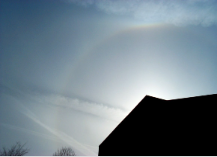Observing Halos - Getting started
Observing Halos - Getting Started: A Comprehensive Guide
Halos, a fascinating atmospheric optics phenomenon, can be observed much more frequently than rainbows. In fact, they can often be seen at least once or twice a week. If you're eager to witness these mesmerizing displays of light in the sky, it's important to know how to locate them successfully and understand their various sizes.
Shielding the Sun for Optimal Viewing
When it comes to observing halos, it is crucial to shield your eyes from excessive glare caused by the sun. Looking directly at the sun can be harmful to your eyes, so always remember to shield both of your eyes. This can be accomplished by using a building, a tree, a post, or simply by covering your eyes with your hand. By taking these precautions, you can ensure a safe and enjoyable halo-viewing experience.
Understanding Halo Sizes
Halos come in different sizes, but the most common one is the 22° radius circular halo. Locating this halo in the sky is relatively simple. Just stretch out your arm and spread your fingers wide. The distance from your thumb to the tip of your little finger is approximately 20°. If you cover the sun with your thumb, you will find that the 22° halo is near the tip of your little finger.
Exploring the Diversity of Halos
While the 22° halo is the most frequently observed, there are various other types of halos that you may encounter during your observations. These include:
- Circumscribed Halos: These halos have a larger radius than the 22° halo and often form a complete circle around the sun or moon.
- Upper Tangent Arcs: These arcs appear as fragments above the 22° halo and can add an extra touch of beauty to the overall halo display.
- Parhelic Circles: These circular halos are located at the same height as the sun and can be seen on either side of it.
Atmospheric Conditions and Halo Formation
The formation of halos is intricately linked to the presence of ice crystals in the atmosphere. These tiny ice particles act as prisms, bending and refracting light to create the stunning halo effects. The specific shape and orientation of the ice crystals determine the type of halo that will be observed.
Common Halo Phenomena
Apart from the 22° halo and its variations, there are several other fascinating halo phenomena that you may encounter while observing the sky. These include:
- Sun Dogs: Also known as parhelia, sun dogs are bright spots of light that appear on either side of the sun.
- Sun Pillars: Sun pillars are vertical columns of light that extend above or below the sun, creating a pillar-like effect.
- Lunar Halos: Similar to solar halos, lunar halos form around the moon and can be just as captivating to observe.
Capturing Halos Through Photography
If you're an avid photographer, capturing the beauty of halos through your lens can be an incredibly rewarding experience. To photograph halos effectively, consider the following tips:
- Use a wide-angle lens to capture a larger portion of the sky.
- Adjust your camera settings to capture the vibrant colors and intricate details of the halo.
- Experiment with different angles and compositions to create visually stunning images.
Seeking Expert Resources
While observing halos can be an enjoyable hobby, there is always more to learn about this captivating atmospheric phenomenon. If you're interested in delving deeper into the world of halos, there are numerous expert resources available online and in books. These resources can provide you with valuable insights into halo formation, different types of halos, and advanced observation techniques.
Conclusion
Observing halos is a fascinating endeavor that allows us to marvel at the wonders of our atmosphere. By shielding our eyes from the sun and understanding the various sizes and types of halos, we can enhance our halo-viewing experiences. Whether you're a casual observer or an avid photographer, exploring the diverse range of halos and their mesmerizing effects can provide endless joy and appreciation for the beauty of nature. So, grab your sunscreen, find a suitable vantage point, and prepare to be awestruck by the breathtaking displays of light in the sky.
Halos are visible much more often than rainbows, usually at least once or twice a week. To find them successfully, shield the eyes from excessive glare and know their sizes in the sky. Shield the sun

Halos are much more easily seen when the sun is shielded. Use a building, a tree, a post or a hand. Always shield both eyes and never look directly at the sun.
Colourful 22� halo and fragment of upper tangent
arc. Sun 20� high 27th April 01. �Bob Fosbury

Halo sizes
The most common is the 22� radius circular halo. It is easily found in the sky. Stretch out your arm and spread your fingers wide. The distance from the thumb to the tip of the little finger is then about 20�. Cover the sun with the thumb and the 22� halo will be near the tip of the small finger.
22� circular halo and circumscribed halo. 21st May 01
Sun elevation 57�. Photo Les Cowley
Note: this article has been automatically converted from the old site and may not appear as intended. You can find the original article here.
Reference Atmospheric Optics
If you use any of the definitions, information, or data presented on Atmospheric Optics, please copy the link or reference below to properly credit us as the reference source. Thank you!
-
<a href="https://atoptics.co.uk/blog/observing-halos-getting-started/">Observing Halos - Getting started</a>
-
"Observing Halos - Getting started". Atmospheric Optics. Accessed on April 19, 2024. https://atoptics.co.uk/blog/observing-halos-getting-started/.
-
"Observing Halos - Getting started". Atmospheric Optics, https://atoptics.co.uk/blog/observing-halos-getting-started/. Accessed 19 April, 2024
-
Observing Halos - Getting started. Atmospheric Optics. Retrieved from https://atoptics.co.uk/blog/observing-halos-getting-started/.